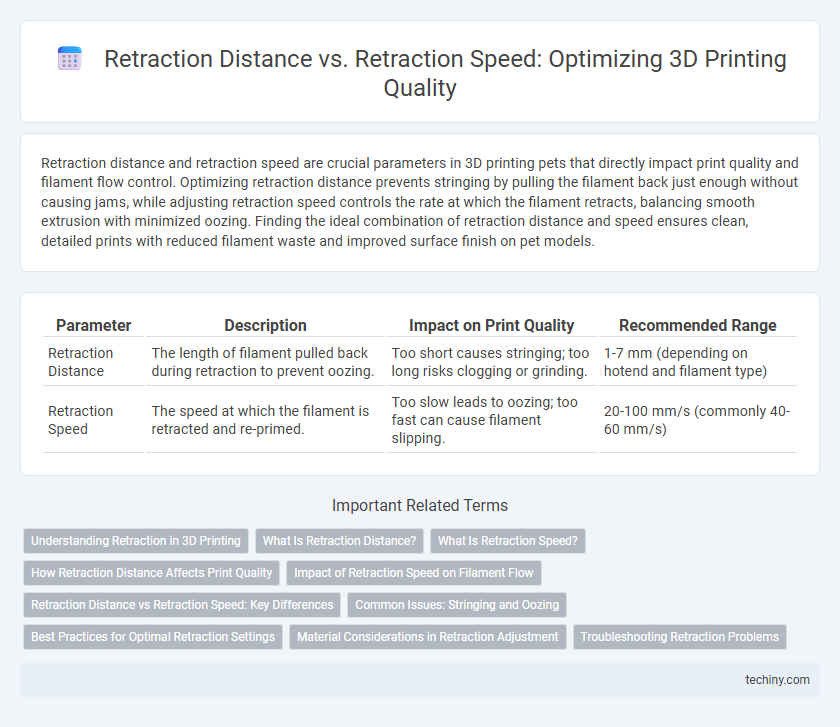Retraction distance and retraction speed are crucial parameters in 3D printing pets that directly impact print quality and filament flow control. Optimizing retraction distance prevents stringing by pulling the filament back just enough without causing jams, while adjusting retraction speed controls the rate at which the filament retracts, balancing smooth extrusion with minimized oozing. Finding the ideal combination of retraction distance and speed ensures clean, detailed prints with reduced filament waste and improved surface finish on pet models.
Table of Comparison
| Parameter | Description | Impact on Print Quality | Recommended Range |
|---|---|---|---|
| Retraction Distance | The length of filament pulled back during retraction to prevent oozing. | Too short causes stringing; too long risks clogging or grinding. | 1-7 mm (depending on hotend and filament type) |
| Retraction Speed | The speed at which the filament is retracted and re-primed. | Too slow leads to oozing; too fast can cause filament slipping. | 20-100 mm/s (commonly 40-60 mm/s) |
Understanding Retraction in 3D Printing
Retraction distance controls how far the filament pulls back into the nozzle to prevent oozing, while retraction speed determines how quickly this movement occurs during 3D printing. Optimizing retraction distance helps reduce stringing and blobs without causing under-extrusion, whereas adjusting speed balances nozzle pressure and print quality. Proper calibration of both parameters enhances print precision and surface finish by minimizing filament leakage and ensuring consistent extrusion.
What Is Retraction Distance?
Retraction distance refers to the length of filament pulled back into the nozzle during a 3D print to prevent oozing and stringing between separate print moves. This measurement is critical for ensuring clean layer transitions and minimizing print defects, especially in printers with Bowden or direct drive extruders. Optimizing retraction distance, typically ranging from 0.5mm to 6mm depending on the printer type, directly impacts print quality by controlling filament pressure and flow consistency.
What Is Retraction Speed?
Retraction speed in 3D printing refers to the rate at which the filament is pulled back or retracted inside the extruder to prevent oozing or stringing during non-print moves. It is typically measured in millimeters per second (mm/s) and directly impacts print quality by controlling how quickly the filament stops flowing. Optimal retraction speed balances preventing filament blobs with avoiding filament grinding or extruder motor skipping.
How Retraction Distance Affects Print Quality
Retraction distance directly influences print quality by controlling the amount of filament pulled back to prevent stringing and oozing during non-print moves. Insufficient retraction distance can cause blobs and strings, while excessive distance may lead to filament grinding or under-extrusion, negatively impacting surface finish. Optimizing retraction distance ensures clean layer transitions and smooth surfaces, significantly improving overall 3D print precision.
Impact of Retraction Speed on Filament Flow
Retraction speed critically influences filament flow stability during 3D printing, with higher speeds reducing stringing by quickly pulling filament back yet risking under-extrusion if too rapid. Optimal retraction speed balances efficient filament withdrawal and smooth resumption of flow to maintain surface quality and prevent nozzle clogs. Fine-tuning retraction speed alongside distance enhances print accuracy and minimizes defects caused by inconsistent filament deposition.
Retraction Distance vs Retraction Speed: Key Differences
Retraction distance and retraction speed are critical parameters in 3D printing that influence filament control and print quality. Retraction distance refers to the length of filament pulled back to prevent oozing, while retraction speed determines how quickly this retraction occurs, affecting stringing and print time. Optimizing the balance between these two ensures minimal stringing and smooth filament flow, enhancing overall print precision.
Common Issues: Stringing and Oozing
Retraction distance and retraction speed play crucial roles in minimizing stringing and oozing during 3D printing. Insufficient retraction distance can cause filament to ooze from the nozzle, leading to stringing between printed parts, while excessive distance may result in filament grinding or clogging. Optimizing retraction speed ensures the filament retracts quickly enough to prevent oozing without causing filament deformation or slipping in the extruder gear.
Best Practices for Optimal Retraction Settings
Optimizing retraction distance and speed is crucial for minimizing stringing and oozing in 3D printing. A retraction distance typically ranges between 1 to 6 mm depending on the printer type, while retraction speed should be set between 20 to 60 mm/s to prevent filament grinding or nozzle clogging. Fine-tuning these settings based on filament type and extruder characteristics ensures cleaner prints and improved surface quality.
Material Considerations in Retraction Adjustment
Retraction distance and retraction speed must be carefully calibrated based on the filament material to prevent issues such as stringing and oozing in 3D printing. Materials like PLA typically require shorter retraction distances and moderate speeds, while flexible filaments like TPU demand slower retraction speeds with reduced distances to avoid filament deformation. PETG often benefits from longer retraction distances combined with moderate speeds to minimize stringing due to its tendency to ooze.
Troubleshooting Retraction Problems
Retraction distance and retraction speed are critical variables in troubleshooting 3D printing stringing and oozing issues, with improper settings causing filament to either leak or jam. Optimal retraction distance typically ranges from 1 to 7 mm, depending on the printer's type and filament material, while retraction speed should be calibrated between 20 and 100 mm/s to balance quick filament pullback without causing grinding or stress. Fine-tuning these parameters minimizes filament stringing, improves print quality, and reduces nozzle clogging in FDM printers.
Retraction Distance vs Retraction Speed Infographic

 techiny.com
techiny.com